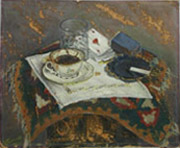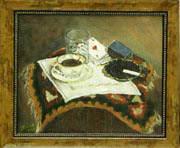|
|
Who cares what happens after I goThrough hundreds of years of recorded creative art, painters were very careful to ensure the technical facet of their work, because they recognized that this would prevent rapid deterioration of the quality of their works. Many art restorers can testify that it is easier to cope with the restoration of a classical oil painting that is between 150-300 years old than with a modern painting produced in a mixed and often unexpected/ OR uncoated technique. At the end of the 19th century the average length of human life was one third shorter than today. The life expectancy of artworks was, contrastingly, far longer. In the past, if an artwork was kept in a location with reasonable conditions, the intervention of the restorer was only necessary after a hundred years or more.   In other words, apart from those few artists whose creative works are declared to be temporary products, in principle, most artists want their work to maintain its quality over time. This is also the desire of those who purchase their works, who do not want a work that they have acquired with their hard-earned revenues, to crack, fade, fissure or tear in front of their eyes. In the simplest case they will need to invest much in the preservation and maintenance and in less optimal cases conservation may not be possible at all, because of the composition of materials and foundation used. This is so in the case of modern works, some of them extremely impressive, which ignore the basic rules of correct painting techniques. “Concern for correct technique will restrict the creative freedom of our pupil/student”; “consideration of the restrictions of materials will arrest spontaneity”. These are some of the justifications expressed by teachers and creative artists. Nevertheless taking care to use materials and techniques correctly did not harm the creative work of the great artistic maestros. Most of this creative works, whose magnificence is unquestioned, were the products of pre-conception that took the necessary stages of performance into account including the proper preparation of a foundation for the painting, placing the colors in the correct order and timing, and including timely application of a protective coating. The exception was Leonardo de Vinci, whose imaginative mind invented many different experiments with materials and techniques which had not been previously tried and some of his works paid the price for this strategy. Often today, artists and their tutors tend to scorn the importance of rules that have stood up to the test of time, and some even completely negate the need for them.  The results of this ‘liberated’ view’, is increasingly being evidenced by us, the restorers of art. Time after time we encounter what from an artistic aspect are excellent works, but painted for example on cardboard, newspaper, or acidic paper which forms a destructive foundation with a very rapid rate of deterioration. The level of acidity of these materials increases over a short time, inter alia because of exposure to light and air with its pollutants, accelerating the natural destructive processes and causing a change in colors, in the foundation and separation of the colors. The use of cheap canvases of inferior quality with ‘Gesso’ with dubious features, stretched over non-standard stretchers, constitutes another facet of the disrespect for knowledge that has been built up and acquired through much hard work over hundreds of years. The results of this ‘liberated’ view’, is increasingly being evidenced by us, the restorers of art. Time after time we encounter what from an artistic aspect are excellent works, but painted for example on cardboard, newspaper, or acidic paper which forms a destructive foundation with a very rapid rate of deterioration. The level of acidity of these materials increases over a short time, inter alia because of exposure to light and air with its pollutants, accelerating the natural destructive processes and causing a change in colors, in the foundation and separation of the colors. The use of cheap canvases of inferior quality with ‘Gesso’ with dubious features, stretched over non-standard stretchers, constitutes another facet of the disrespect for knowledge that has been built up and acquired through much hard work over hundreds of years.Other diseases of the trade are for example, the mixing or combination of oil colors with acrylics, painting on canvas or wood without a proper base color (Gesso), or the use of dry pastels on top of oil colors – a tested recipe for the creation of maintenance problems. These problematic techniques do indeed often achieve amazing effects, but their profit, if it can be dubbed so, results in a loss, and their life is severely limited! A female artist from the North of Israel came to us with a collection of her works, in which she depicted milestones in her creative path. Most of them were painted in mixed techniques on cardboard, and their state a mere 15-20 years after their production was rather bad. This was unnecessary, for if she had relied from the start on the abundant extant knowledge concerning art production, the calamity would have been avoided. This was an unhappy story, especially since due to lack of funds the artist could not allow herself even to conserve these works of art let alone restore them and so they continued to deteriorate until they were destroyed. In another case, a couple purchased a fascinating modernist work depicting images of prehistoric caves at a price of $14,000. The artist had used ‘primitive’ techniques and placed layers of acrylic color, plaster, dry pigments and pastel colors on a huge canvas. The result was indeed fascinating to see, but impossible to conserve properly. All preventive treatments would have completely altered the character of the work. Another famous example for the price demanded due to lack of attention to technical aspects, which in this case did not stem from disrespect or lack of knowledge but rather from the artist’s impulses and unstable mental state, is the work of Van Gogh. These were created with feverish zest, without consideration for factors such as the type of color, the length of time needed for each layer and consideration of ‘fat’ and ‘thin’ colors. Consequently some of them are disintegrating, and if they did not have such considerable value, it is doubtful whether such huge and expensive efforts would have been invested in their conservation. Thousands of dollars are invested per annum in their regular maintenance. The conclusion from all the above-mentioned examples must be that it is impossible to ignore the need for intelligent use of artistic materials. It is difficult to understand why this basic aspect is ignored in most schools of arts. These schools do not train the future generation of artists to properly conserve their art works or the works of their colleagues. First published in the journal “Auction. Updated and extended in April 2008. © All rights reserved to Michael Karov Karo, Karo Arts Back to articles |
|
Karo-Arts.com © 2008 | דף הבית - קארו אמנויות
|

